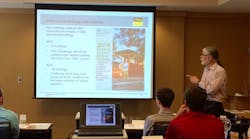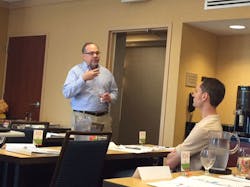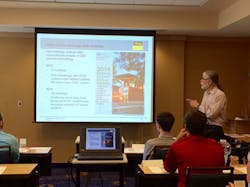Latest from Piping Contractor
Sponsored
Recently I attended a water quality and an energy and comfort performance seminar sponsored by Viega in Washington D.C. Both sessions were eye opening for me — I now know so much more about legionella outbreaks and radiant systems than I ever thought I would! I can see why many industry professionals and university professors study these two subject matters — there is so much to research and learn.
The first session held on Tuesday, May 12, was Pathogen Risk Reduction by Design: Water Quality & Minimizing Microbial Growth, presented by Tim Keane, consulting engineer at Legionella Risk Management LLC.
Keane started the presentation by stating that ASHRAE Standard 188P will increase awareness of legionella outbreaks by noting things to do to minimize legionella outbreaks via piping designs.
And what types of buildings are most susceptible to a legionella outbreak? Healthcare facilities, medical treatment facilities, hotels and educational facilities are the buildings most at risk. Also, outbreaks have been sourced to aerosols from cooling towers, showers, aerators, faucets, respiratory therapy equipment, room-air humidifiers, central humidifiers, decorative fountains, ice machines, whirlpools and clinical equipment.
“Besides minimizing outbreaks via piping designs, the most effective way to prevent legionella is to have hot water temperature at 124°F or above at point of use,” said Keane.
Water temperature plays a huge role in legionella bacteria growth. Below 68°F legionella does not grow but it does not die either. The ideal temperature for it to grow at is 85°F to 110°F. At 122°F legionella survives, but doesn’t multiple. At 140°F legionella dies within 32 minutes. At 151°F legionella dies within two minutes above 160°F it does instantly.
Climate also plays a role. In dry places, like Las Vegas, the risk is low for an outbreak from an outdoor fountain or a cooling tower because the water aerosol evaporates quickly in the very dry weather, but it is higher from potable water because ambient air and water temperature is so high in the desert. The East Coast of the U.S. reports higher rates of Legionnaires’ disease but we are not sure if this is from better diagnosis or greater incidence of disease.
It was interesting to find out the newer hospitals are at a higher risk of an outbreak because of stagnant water in the cold water supply distribution lines.
New hospitals have four times as many sinks per patient as older hospitals.— Tim Keane
“In new hospitals you have one person in a room, a sink as soon as you walk in that room, also the room for the doctor or nurse to wash their hands, and another sink in the bathroom,” said Keane. “On top of that you have waterless hand cleaner, so nobody uses the sink. New hospitals have four times as many sinks per patient as older hospitals."
The solution to the stagnant water problem is to choose a series installation or loop installation. With these two installations, every time someone washes their hands the showers are being flushed out to prevent stagnation. “This is a simple solution to decrease install cost, save energy and reduce water borne pathogens,” said Keane.
Keane also discussed case studies about legionella outbreaks. One very interesting study is of an outbreak that stemmed from a small fountain in a Rapid City, S.D., Mexican restaurant. This caused a Legionnaires disease outbreak in which one person died and 27 people were hospitalized. When Keane first went to the area to investigate what and where the outbreak stemmed from, he sampled more than 400 locations in the city (none of them being the source of the outbreak), finding out later that the outbreak originated from an ornamental fountain located in a Mexican restaurant.
“If a heat source is added to a fountain you can create legionella; heat load has been present in every fountain associated with a LD outbreak,” explained Keane. “If you do put a fountain in a building lobby make sure there are no incandescent lights; locate all components in conditioned space; and no nearby heat sources.”
Keane also discussed the Bellevue Stratford Hotel case study, which is familiar to people since this is the first time legionella was identified — after the 1976 American Legion convention took place in Philadelphia. This first identified outbreak was deadly – taking the lives of 34 people and 221 people became ill.
Legionella is quite young compared to other bacteria — it goes back to 1947 — when it was identified in a blood sample. This earlier case was confirmed once legionella was identified via the Bellevue Stratford outbreak.
Thermally activated building systems
The following day, Energy & Comfort Performance of Radiant Slab Systems was the topic of interest, presented by Fred Bauman P.E. of the Center for the Built Environment, University of California, Berkeley.
Bauman’s presentation focused on TABS (thermally activated building systems), which is one of three main types of radiant systems. TABS is a system that is made of an overhead slab or floor slab, which is always a large surface area. With TABS it is possible to pre-cool to reduce peak cooling loads. In Europe, TABS are used successfully; however, it is still catching on in the U.S.
“Ten to 20 years ago, people in the U.S. weren’t familiar with TABS,” said Bauman. “Now we are catching up and have better guidelines, etc. There is still a lack of familiarity of TABS in the building industry, which is why it’s so important to get the word out.”
Bauman discussed air versus radiant cooling systems. Air systems remove heat using convention only while radiant systems remove heat via convection and radiation. Air systems are design to maintain constant zone air setpoint temperature and to meet a single peak cooling load value while radiant systems are designed to maintain operative temperature within comfort range. Radiant systems provide sensible load control with a separate air system for ventilation and latent load control.
“Building operators primary purpose is to make people comfortable.”— Fred Bauman
Thermal comfort was another interesting topic Bauman discussed. He started the discussion by pointing out that thermal comfort is a state of mind. “There is a subjective component with this, everyone is different,” said Bauman.
Bauman reviewed research and surveys conducted at the CBE, regarding occupant thermal comfort in buildings with radiant cooling systems and air systems. “Building operators primary purpose is to make people comfortable,” said Bauman. “And it’s so important to keep in mind that the ‘state of mind’ of the occupants play a big role.”
When Bauman wrapped up the morning part of his presentation, he noted that more research is needed regarding thermal comfort and what type of system is most effective — radiant or all-air systems.
During the afternoon, Bauman discussed cooling load fundamentals, control strategies, energy efficiency, design guidelines and tools, and sizing examples. He also reviewed case studies, spoke of the many buildings he has visited and done research on, and his own lessons learned.
My blog is just scratching the surface of these two topics. There was so much knowledge and information about both Pathogen Risk Reduction by Design and Radiant Slab Systems shared last week in Washington D.C. If one of these topics intrigues you, you will have a chance in the near future to attend these seminars.
Seminars are schedule for Oct. 13 in NYC and Nov. 3 in San Francisco. More information on these seminars, plus other courses, is available on the Viega website.
Candace Roulo Blog | Senior Editor
Candace Roulo is a senior editor of Contractor magazine, based in Chicago.




